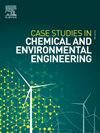哥伦比亚瓜希拉海岸沉积物中微塑料毒性的分子机制及新出现的生态风险
Q1 Environmental Science
Case Studies in Chemical and Environmental Engineering
Pub Date : 2025-01-19
DOI:10.1016/j.cscee.2025.101108
引用次数: 0
摘要
海岸带是连接陆地和海洋环境的独特过渡区,被认为是陆源聚合碎片进入海洋的主要载体。本研究首次尝试了解La Guajira最活跃的沿海生态系统沉积物中微塑料毒性的分子机制,以及对新出现的生态风险的环境影响,确保最大的覆盖范围,以有效地估计您的积累的实际负荷。4个地区的平均丰度为102±7.86粒/kg,其中列奥哈察、迪布拉、马纳尔和乌里比亚的平均丰度分别为39±15.43、109±25.45、211±13.17和50±29.56粒/kg;据估计,瓜希拉海岸的微塑料负荷为每年14.71万粒/吨,这被认为是世界范围内的中等丰度。发现的微塑料形态以碎片(55.5%)和薄膜(29.5%)为主,在高辐射、高温和盐度条件下表现出降解的迹象,影响了三种聚合物的表面氧化率和污染物的吸附能力,其中聚丙烯(PP)占主导地位。其次是聚乙烯(PE),其空间分布与旅游、渔业和城市活动等因素有关。基于污染负荷指数(PLI)的生态风险评价结果显示,微塑料污染程度较低;然而,聚苯乙烯(PS)等有害聚合物可能导致潜在生态风险指数(PERI)和聚合物危害指数(PHI)较高,这对生物群和人类健康构成风险,引起关注,需要采取适当的控制措施来保护海洋生态系统。本文章由计算机程序翻译,如有差异,请以英文原文为准。
Molecular mechanisms of microplastic toxicity in coastal sediments of La Guajira Colombia and emerging ecological risks
Coastal zones are unique transition areas connecting terrestrial and marine environments, recognized to be primary transporters of terrestrial-origin polymeric debris into the oceans. This study is the first attempt to understand the molecular mechanisms of microplastic toxicity in sediments of the most active coastal ecosystems of La Guajira and the environmental implications regarding emerging ecological risks, ensuring maximum coverage to estimate the actual load of your accumulation effectively. The four areas studied show an average abundance of 102 ± 7.86 particles/kg, with a wide variation of 39 ± 15.43, 109 ± 25.45, 211 ± 13.17, and 50 ± 29.56 particles/kg found in Riohacha, Dibulla, Manaure, and Uribia, respectively; the microplastic load was estimated on the coast of La Guajira at 14.71 thousand particles/ton annually, which is considered a moderate level of abundance worldwide. The morphology of the microplastics found was dominated by fragments (55.5 %) and films (29.5 %), showing signs of degradation under high radiation, temperature, and salinity conditions, influencing the surface oxidation rate and the adsorption capacity of contaminants that were identified in three types of polymers by Fourier transform infrared spectroscopy (FTIR), of which polypropylene (PP) was the most predominant, followed by polyethylene (PE) with a heterogeneous spatial distribution associated with factors such as tourism, fishing, and urban activities. The ecological risk assessment based on the pollution load index (PLI) showed a low degree of microplastic contamination; however, hazardous polymers such as polystyrene (PS) can contribute to a high Potential Ecological Risk Index (PERI) and a high Polymer Hazard Index (PHI), which poses a risk to biota and human health, generating concern and requiring appropriate control measures to protect marine ecosystems.
求助全文
通过发布文献求助,成功后即可免费获取论文全文。
去求助
来源期刊

Case Studies in Chemical and Environmental Engineering
Engineering-Engineering (miscellaneous)
CiteScore
9.20
自引率
0.00%
发文量
103
审稿时长
40 days
 求助内容:
求助内容: 应助结果提醒方式:
应助结果提醒方式:


